Does cropping fill your photos with more noise? Is not filling the frame killing your images? Is there any way to stop it?
In this video, we’ll explore comparative output and see first-hand the effects that cropping can have on the noise of our final output image. This is one video every photographer who has ever used a crop tool absolutely must see. It’ll change your approach to photography – or at least surprise the heck out of you!
.
Update: I’ve had a lot of people asking if using something like Lightroom’s Super Resolution to make the cropped image larger would help. So, I enlarged the heavily cropped image use Super Resolution and then tired it again. Although the file is bigger, the output looks nearly identical to the non-enhanced version. I guess, garbage in, garbage out as they say in the IT industry.
(Click the image to enlarge – you may have to click it again when it opens in a new tab to see the full size.)
PS – If you enjoyed this post, I think you’ll REALLY like my e-books and video workshops! Thousands of pages and hours of videos filled with tips, tricks, and techniques – all my best content! Check ’em out – click here (hey, it’s free to look).

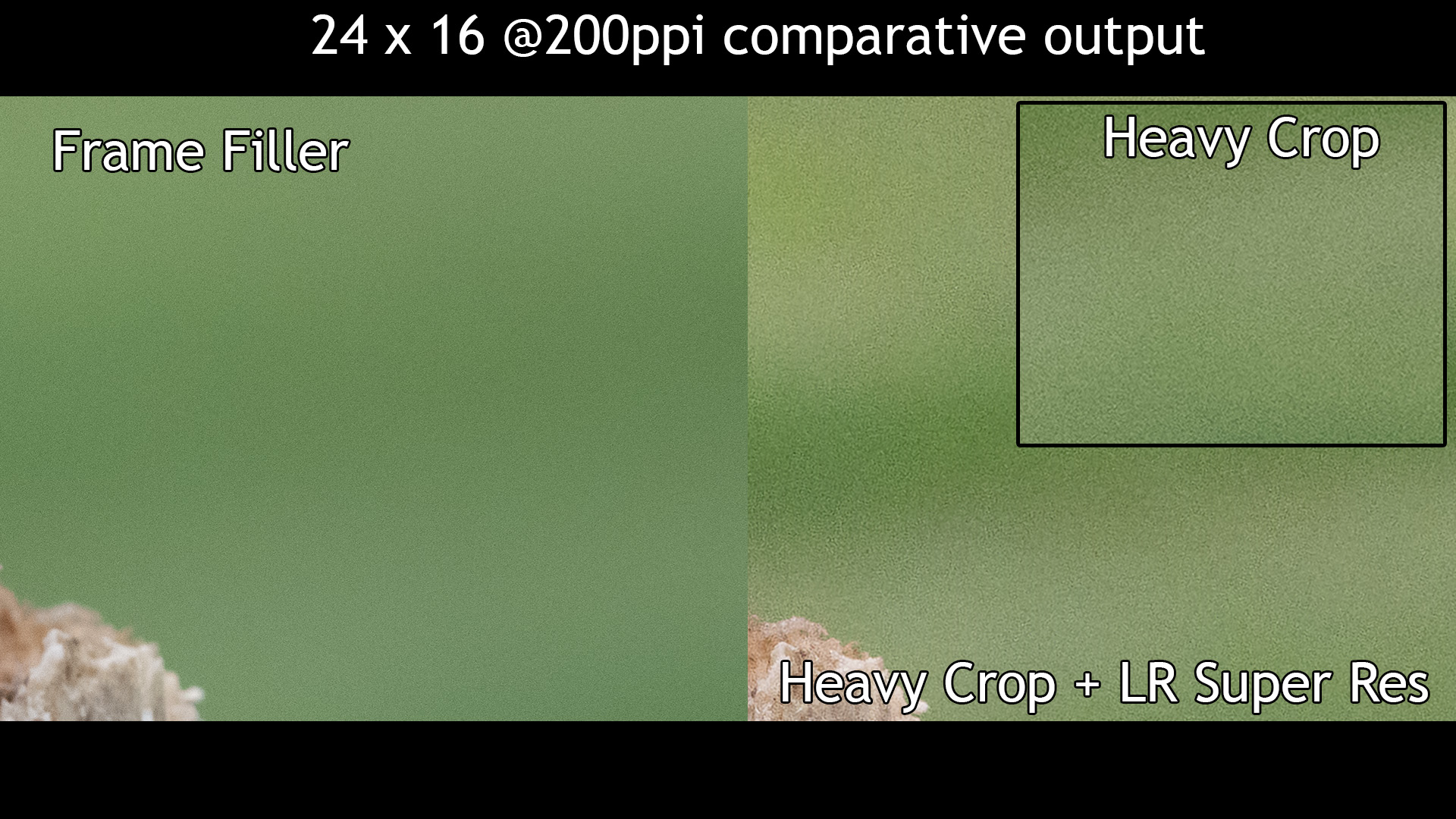
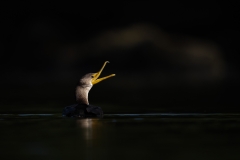
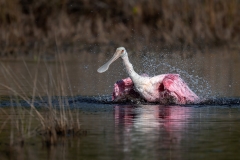
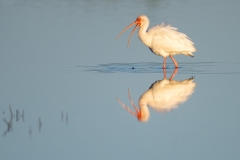
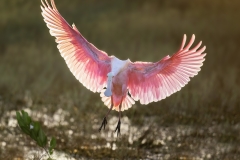
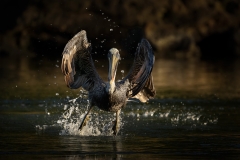
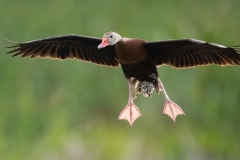

Helpful information, Steve. But we crop, use TC, photograph with high ISO not because we like to do so. The best shot is on ISO 100, close to the subject and with beautiful lighting. Unfortunately more often we seat in the dark forest far from the bird. Noisy high ISO crop. What to do? Actually Topaz Denoise can help a lot.
The thing is, there is a LOT we can do. Often people throw their hands up like this, but the truth is, you can do things like shoot more frames at slower shutter speeds and lower ISOs so cropping isn’t as damaging, you can get out a tripod to do the same, you can work on fieldcraft to get closer – or go to places where you can get (safely) closer. In fact, I often go past opportunities where others are shooting something that’s too far off and find something closer. There are dozens of ways to improve your odds… Read more »
Thank Steve! So good video like always !
I use ON 1 Photo Raw for my photo editing. It has No Noise AI built in and it does a fantastic job of removing noise. I use a Nikon Z6ii and a Tamron 18 to 400 mm lens for my take everywhere lens.
very helpful and great for shooting Hawks in flight
This plus Birds in Flight a great plus
Very helpful. I’m find I’m on a constant see-saw with ISO. I shoot a lot of song birds (warblers). They don’t sit still and they are almost always in dark/full shadow environments. Even with a monopod I keep the shutter speed up (500-800) with my D500 and 500mm PF and consequently the ISO will be as much as 3200 (sometimes 6400). And yet there are times I’m shooting birds in my backyard in sunlight allowing me to go low on ISO. The quality of low ISO shots is amazing. Mind-blowing really. Do you think it is better to shoot in… Read more »
The problem is when you underexpose and then bring up the exposure afterward, it’s the same as shooting the proper ISO in the field. No free lunch. ISO is simply a brightening control – it’s not getting any more light to your sensor, it’s more like a volume knob for brightness. You can turn it down in the field, but when you turn it up in post the noise is right there. You have to increase the light coming to the sensor, either with shutter speed or F/stop.
You see…this is why I read your stuff! I learn so much. Since f/5.6 is as low as I can go…I just have to develop better monopod technique at lower shutter speeds when shooting warblers. That’s the bottom line. Then when cropping becomes necessary, I have more pixels.
BTW – I also need them to slow down on occasion…any tips for that? Bird mind control. LOL!
LOL, the birds really are the issue – that’s why I had to use a fake one for this demo! (Although I think someone on YT thought it was real and couldn’t figure out how I got it to hold still for so long!)
Steve…quick update. This last month I set my Shutter Speed minimum in Auto ISO on my D500 to 1/250. This has made a world of difference. You are so right about the importance of getting more light. I’m getting much better pictures and detail…even at higher ISO (sometimes 2500 in heavy tree canopy). Appreciate your tip.
Great discussion points and practical use tips Steve! I shoot with a D850 and 500mm PF wildlife all the time with your setting suggestions and find in higher ISO environments you have to lower the shutter speeds while manual mode and auto-ISO settings, and try to keep the base/lower ISO as low as possible. For brighter or non-cloudy days I use your suggestions for ISO 64 to 200 depending on overall light intensity, and if going into shadowy environments (trees, forests, cloudy, etc.) try to remember to bump up the lower ISO to 400-800 and lower the shutter to an… Read more »
As always, an excellent video, which goes into the real detail of how to take better images, and you explain things just as if I were asking for the fine details of a technique, in person. Thank you Steve! I have found that using LR Enhance on the uncropped and unsharpened raw file, then saving it in LR, then putting it through Topaz Denoise or AI Clear at a 100% crop so that at that size the noise only just disappears, then using the Topaz sharpening tool still at 100% crop, then saving it back into LR, then cropping the… Read more »
Once again a great video that truly helps, thanks. Just wondering, I live between Yellowstone and Glacier National Park. How about you come visit for a few weeks, stay here at the house and I follow you around the parks and the Rocky Mountain Front while learning a few things? 🙂 (Just kidding, I’m not a stalker.) If you ever are in the neighborhood, it would be great to meet you.
Thanks 🙂
I enjoyed you video on the effect of cropping to the increase in noise. With the addition to LR and PS of the new Enhance feature where AI is used to increase the pixel count do you see this a possibly mitigating the effect of crop noise? Let me know your thoughts.
Hi Herman – see the image just below the video. I tested it and it didn’t make much of a difference. No free lunch…
Excellent video/information, Steve. Unless I develop wings and learn to fly I’m stuck with heavy cropping for BIFs. Additionally, many birds alight on the highest branch which again requires heavy cropping. I have both Topaz DeNoise AI (latest version) and DxO Pure Raw. The DxO Pure Raw is much better than Topaz and has become the initial step in my work-flow for all shots.
I’m glad you have recovered well from Covid and are able to continue with your fine work.
Agree as impossible to get closer to BIF alot of the times. I use Topaz denoise latest, had DXO prime but was not better, which DXO are you talking about. Thanks
It’s called DxO Pure Raw – it applies lens correction, noise correction and sharpening to raw files.
Great explanation, Steve! Regarding the situation where the shot you have in mind won’t work without a heavy crop, I find it helpful to challenge myself to find a different composition that will work. For example, instead of a single bird in flight, what about the flock over the water? Or the reflection of the flock over the water? It is an artistic challenge that I found can turn a potential disappointment into a satisfying experience.
Another excellent explanation and video. Thank you so much for posting it. With LR’s new Photo > Enhance with Super Resolution, in your opinion, would that be another viable tool to address images with higher amounts of noise?
Nope – I just tried it and the results are amazingly close to what you’d have without it. I just added my results to this post under the video.
Thanks for diving into the testing on that, Steve. Too bad the results from using Enhance…didn’t enhance(?) after all. Back to honing those stalking/sneaking skills, along with the exposure adjustments you mentioned in your video. Great information, as always – thanks again! -EJ
Hi, My long lens is 100-400mm. I am at the edge of a lake, and the birds-in-flight move rapidly. I can’t get any closer without hip-waders/canoe and I need 1/2500s shutter to capture motion and splashing water. Buying an 800mm F4 prime is not an option.
My choice is to shoot at 400mm and crop to 0.4x height and width, or to add teleconverters which soften the pic and raise the ISO. I would rather crop.
By the way, I like Lightroom Super-Resolution, and Topaz DeNoise Ai.
(Sony A1 w/ 50MP)
I’m just the messenger, I can’t fix the physics of the situation 😀
Hey Steve, As always great information, but have you ever thought about talking slower so that you could get your message across without us having to pause, rewind listen again, work out what the point was that you raced across and then we start again. Fair dinkum mate, you give us sooo much info to digest that not all of us are capable of taking it in at ‘light speed’. . . I remember when you made the instructional video on Lightroom ( Still waiting for part two by the way) and you were sitting at your computer desk, comfortably… Read more »
As usual, another informative and easy to understand video. The main thing I’ve learned from you is when to not bother with a shot that I now know just isn’t going to work. The cards not full, but what’s there is usually better than my previous work.
Thanks 🙂
Thanks Steve.
NR in post can reduce noise and there are claims that AI can protect detail. True?
Two thoughts. First, keep in mind that you can also do NR in post to a frame filling image and get even better results than from the cropped one 🙂
Second, AI does a good job at protecting detail, however, it’s not perfect. It will sometimes sacrifice detail to reduce noise. The larger the detail though, the better your chances. So, with a frame filling image, the results are better (in fact, sometimes nothing short of amazing).
I was given a lesson in IQ when a raptor with prey landed in my backyard. It wasn’t going anywhere so it was possible to get closer than normal and progressively lower the SS well below my normal grabshot speed. Bringing the ISO right down produced a level of crispness and contrast I didn’t think the D500 was capable of. It was an eye opener.
It’s funny, I’ve had similar experiences. I think that’s why I’m such a fan of tripods – I’m always dropping ISO and I think I’m now addicted to clean detail!
Yes. Well, it’s equivalent to getting better glass at no cost isn’t it.
Absolutely.
Thanks! I am an avid birder and dang I’d like more keepers. I shoot a Nikon D7500 and for birding, a Tamron 150-600 G2. Decent equipment for me so the problem is me! LOL. Learning bird behavior of my regulars, great egrets, blue herons, cormorants, and the like has helped me a lot. I think I’ve seen you address that too in a video. Anyway, I am a fan and thanks for these. I have two of your books too on AF and on Metering.
Thanks!!
Hi, Steve! Thanks for this very helpful video. Lightroom recently released an update that improved its Photo > Enhance feature to specifically increase resolution for cropped images. Have you experimented with that feature yet?
I haven’t had a chance to play with it yet. Still, there’s never a free lunch and there’s little chance any kind of enlargement software can duplicate the same image and noise level that you would get filling the frame.
Thanks Steve for another informative video. You have such a talent of explaining things in a way that all level of photographers will benefit. Can I make the assumption that these rules are similarly weighted using a crop sensor (Nikon D7500 user) camera?
Yup, spot on. Applies to any sensor.
Another great video with easy to understand language and examples. Thanks for making videos which are pertinent to become a better photographer.
Thanks for the kind words 🙂
Heh Steve another excellent and informative video and topic. Cheers mate and I hope you are still doing well.
Thanks David 🙂 Yes, still doing well, pretty much fully recovered now 🙂
Excellent news Steve.
Nice video Steve. I worry about noise quite often but when you need a shutter speed of 1/4000, or higher, such as wild bird photography I normally will go to ISO 3200 so I have the shutter speed. When you’re on an airboat exploring the swamp in Florida (not Washington DC) you just don’t have time to adjust much of anything other than zooming for composition. Had amazing results on a trip recently to Kissimmee. Lots of room for thought here!
Thanks David 🙂
Sometimes it’s just tough to make things work and you do the best you can. Topaz and similar software can help.
Thanks, Steve! Another great video. Have you tried products like the Topaz Suite, namely DeNoise and Gigapixel. If so, how do you like them? I like DeNoise a lot. There is some loss of detail, but these people have done a nice job of making AI work.
I do like Topaz Denoise AI. Works really well. I haven’t been overly impressed with Gigapixel though. Anytime I’ve used it the resulting image, while larger, just isn’t close to the same as had I been closer to my subject in the first place.